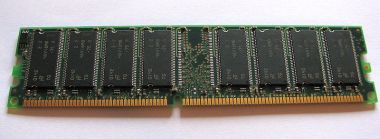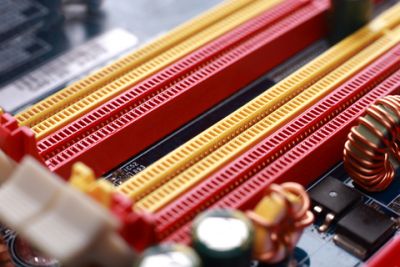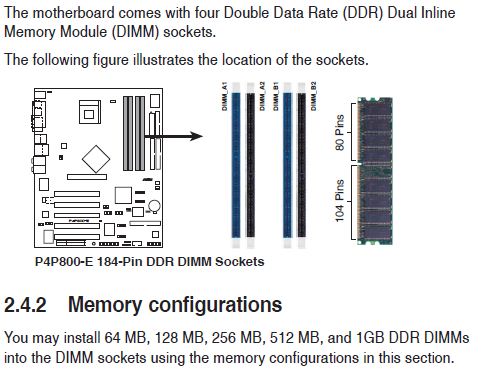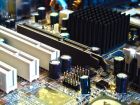Computer Memory.
Random Access Memory or RAM demystified
There are different types of computer memory. The most common type is RAM or Random Access Memory. What are the different types, how does it work and how much do you need?
Computer memory or RAM (Random Access Memory) is just another form of storage used by the CPU. It's faster than a hard disk but slower than the CPU's level 1 or level 2 cache. Its known as volatile storage because the data is lost when you switch your PC off.
RAM is very easy to upgrade and isn't very expensive.
It's called Random Access Memory cause the data can be accessed from any of the chips on the memory module regardless of it's location.
DDR DIMM
Why do we need RAM?
Let's first discuss the speed aspect of computer memory. To put this into perspective, I'll use an example of a person sitting at a desk and looking for a pen.
Level 1 cache can be compared to a person sitting at a desk, looking up, seeing the pen and picking it up. It takes mere seconds.
Level 2 cache can be compared to the person looking for the pen, not finding it on his desk, opening the drawer and picking up the pen. It took a little longer but only two or three seconds.
Computer memory or specifically, RAM can be compared to the person looking for a pen, not finding on the desk, opening the drawer, not finding it there, getting up, walking to a desk next to him and picking up the pen. This takes longer than looking for the pen on you desk, but still doesn't take that much time.
A hard disk can be compared to the person not finding a pen on his desk, in the drawers or on the desk next to him. He has to physically walk out of the office to the office next to him and finding a pen on the desk there. It can take minutes.
The above is just an example to give you an idea of the time relative to computer time. In computers, we are talking of mere milliseconds.
As you can see disks are very slow compared to computer memory. That's why you need RAM. It basically bridges the gap between the slow hard disk and the CPU's L1 and L2 caches.
Why can't I just use L1 and L2 cache? Good question.
Simple answer, it's expensive.
L1 and L2 caches are built into the physical CPU and costs a lot to make. That's why you only have killobytes or megabytes of it.
Check the pricing on CPU's with large L2 caches. It's much more than CPU's with smaller caches.
Different types of RAM
There are different types of computer memory available but the most common used in PC's are DDR SDRAM or Double Data Rate Synchronous Dynamic Random Access Memory. They have also over the years upgraded this standard and now you have DDR2, DDR3 and DDR4 will probably be released somewhere in 2012.
In the good old days computer memory consisted of SIMM's or Single Inline Memory Modules. You had to populate the computer memory in you PC with 2 identical size and speed SIMM's. Well, most of the times anyway.
The reason was that the SIMM's data width was less than that of the memory bus. The SIMM could only provide 8 bits of data while the system bus was 16 bits. The SIMM also had only 30 pins that connected to the memory slot on the motherboard.
Then came the DIMM or Dual Inline Memory Modules. This was adopted as the industry standard after the SIMM. These modules have 168 to 240 pins, depending on the type, and can range from 8 mega byte to 1 gigabyte in size. You now get from 2 to 4 gigabytes and some servers even use 8 gigabyte DIMM's.
Why are the pins important?
The normal DDR or DDR1 DIMM's have 184 pins. DDR2 and DDR3 have 240 pins. Why is this important? Let's say your motherboard supports only DDR1 DIMM's and you heard about this cool new DDR2 DIMM.
You go out and buy the DDR2 DIMM. You then try to install it on your motherboard, but it wont fit. Why?, because DDR only has 184 pins and DDR2 have 240 pins.
So what about DDR2 and DDR3, they have the same number of pins? Can they be mixed. Unfortunately not. You see, there are also notches on the DIMM that will prevent you from inserting a DIMM in the wrong slot.
There's a reason for this and it has to do with voltage support and speed. I don't want to get to technical here but it's designed like that to protect you from inserting the wrong component in a slot and maybe frying your PC or the component.
Keep one thing in mind, technology changes rapidly. Today's new computer memory may be obsolete tomorrow. That's just how it is. I have bought many a component that gets replaced by a better one a couple of months onward.
DDR DIMM's are widely used in desktop PC's. If you open up your PC, there's a good chance you will have DIMM's. Computer memory DIMM's are fitted onto you PC's motherboard by means of memory slots or DIMM slots. Below is a picture of what the slots look like on a motherboard.
Memory slots on motherboard
What do laptops ues?
Laptops uses computer memory called SODIMM's or Small Outline Dual Inline Memory Module. As the name implies it's small so it can fit into your laptop or notebook which is also small.
Some manufacturers use proprietary modules, but most laptops uses SODIMM's these days.
How much RAM do I need?
With today's operating systems and programs, you need as much computer memory as you can afford. I cannot give you an exact amount here but get as much as you can. Next to the CPU, RAM is the second most important component in your PC.
I would not buy a PC today with less than 1 Gigabyte of memory. If you are into games and sound, get 2 gigabytes or more. If you feel your computer is getting sluggish and has to access the hard drive frequently, then there is a good chance that you don't have enough RAM.
It's relatively cheap and easy to install.
A word of warning! Be careful when you upgrade your RAM. Normal 32 bit operating systems can only access up to 4 gigabyte of RAM. If you install more than 4 gigabyte, then get the 64 bit version of the operating system.
Some sales guys at PC shops don't know this and it's very possible that you might upgrade your PC's RAM to 8 gigabyte but you only see 4 gigabyte. If this is the case, then ask for the 64bit version of the operating system.
It doesn't cost more and you will have access to your 8GB of RAM.
How do I know what RAM to buy for my PC
Another great question. Check you motherboard manual. There you will find out exactly how much RAM you'll need and what size and type of DIMM's to get.
You can also open your computer case and remove the existing DIMM's installed and check the type and size and so on. But some motherboards have restrictions and only the manual will give you that info.
Below is an example of my motherboard's manual and the RAM configuration.
Extract of motherboard manual
As you can see from the above extract, the manual tells me exactly what type of DIMM's and the total amount I can put in. So, my motherboard can take up to 4 DDR or DDR1 DIMM's and I can have a maximum of 4 gigabyte installed.
Let's look at some other info.
Below is an extract of the specifics of how the memory should be populated.
Memory population specifics from manual
This shows me where my memory slots are located and what size DIMM's I may use. Also further down in the manual, (not shown here) they say that the blue slots should be populated first. These are numbered as DIMM_A1 and DIMM_B1.
You will also find memory frequency information in the manual to get the best speed DIMM's for your motherboard.
As you can see, you get a lot of info from the manual. So download it from the manufacturers website. It will save you a lot of headaches.
What else do I need to know?
If you start to read more about RAM you will find that the topic can be very technical.
Like the speed, ecc (error correcting code) and buffers. There is no need to really get into these areas but I just need to explain two more things.
When you buy or upgrade your computer memory, be aware of the following:
1. If your PC motherboard does not support ECC or buffered (also referred to as registered) DIMM's, then don't buy it. Although they might fit in the memory slot, they will not work.
Servers use these types of modules to ensure data integrity.
2. Check the speed of the memory bus from the manual. Try to use the fastest DIMM you can buy that's supported by the motherboard.
Remember to keep to your manual specifications. Don't try to buy DIMM's that are too quick for the motherboard. The motherboard will throttle it down to a slower speed.
This means you have spent money on fast memory and you have thus wasted your money cause you are not running at optimal speed.
Return from Computer Memory to Computer Components
Back to What is My Computer



